Masks and Talismans: Kurt Busiek’s Astro City
 A couple Wednesdays ago, I did something I haven’t done in ages. I went down to my local comic store on new-comic day (which is Wednesdays) and bought a new super-hero comic off the rack. Not a Marvel or DC book, though — not really, though it was published by DC’s Vertigo imprint. This was the return of a series first published in 1995, under the Image Comics banner. The title’s moved around a fair bit since, and frequently been on hiatus from regular publication. But it’s back now, and hopefully for a long time to come. It’s Kurt Busiek’s Astro City, and I want to talk about what it is and why I’m going to be buying it going forward.
A couple Wednesdays ago, I did something I haven’t done in ages. I went down to my local comic store on new-comic day (which is Wednesdays) and bought a new super-hero comic off the rack. Not a Marvel or DC book, though — not really, though it was published by DC’s Vertigo imprint. This was the return of a series first published in 1995, under the Image Comics banner. The title’s moved around a fair bit since, and frequently been on hiatus from regular publication. But it’s back now, and hopefully for a long time to come. It’s Kurt Busiek’s Astro City, and I want to talk about what it is and why I’m going to be buying it going forward.
In this comic, Astro City’s a metropolis located somewhere in the continental United States; it’s a hub for super-heroic activity, and has been for decades. Mad science, high sorcery, aliens: all of that. Men and women in strange costumes. Wild sprawling battles. Secret societies and crime rings. Everything you expect from super-hero stories — but not told the way you expect it. Because alongside all that imaginative chaos, there’s a city. Filled with millions of human beings. Astro City tells us their stories, as well. It’s an anthology book, alternating single issues and longer arcs, displaying incredible dramatic and emotional range for a genre often considered to have distinct formal limitations.
Writer and creator Kurt Busiek summed it up as “about being human among the superhuman,” which is true and also only part of it; superhumans are often the main characters of the stories, but Astro City as a place gives them a kind of context, a human connection, human meaning to the fantasy of their powers. Astro City uses the super-hero form as a way to talk about human beings, and vice-versa. It is, from one point of view, a struggle with the super-hero traditions of the past, an examination of genre conventions, a turning of those conventions to new ends. First appearing not so long after the ‘deconstruction’ of super-heroes exemplified by Watchmen and The Dark Knight Returns, Astro City was at one time considered as part of a wave of ‘reconstructionist’ titles; but it was always more than that. It was, and is, a comment on super-heroes — working with perhaps the most meta-fictional of all genres, a form that endlessly reinvents its own past, Busiek pastiches and re-imagines the whole history of hero comics, creating a kind of ocean of story out of which he can draw seemingly endless incidents and anecdotes.
 The publication history of the series is complex, due in part to movement among various related publishing companies, and in part to problems with Busiek’s health. I have to admit I lost track of the title midway through the epic-length “The Dark Age” storyline, when it was frequently running late. But Busiek, by his own account, is feeling much better, and he’s working well ahead on the new issues. Everything published so far has been collected in a series of trade paperbacks, but the anthology-style structure of the book, the lack of an overarching plot, means you can begin reading the book almost anywhere.
The publication history of the series is complex, due in part to movement among various related publishing companies, and in part to problems with Busiek’s health. I have to admit I lost track of the title midway through the epic-length “The Dark Age” storyline, when it was frequently running late. But Busiek, by his own account, is feeling much better, and he’s working well ahead on the new issues. Everything published so far has been collected in a series of trade paperbacks, but the anthology-style structure of the book, the lack of an overarching plot, means you can begin reading the book almost anywhere.
Before examining more closely what Busiek does with the series, it’s important to look at the work of his collaborators. Artist Brent Anderson’s drawn the book from the start, sometimes with inks from Will Blyberg. Alex Ross has been the regular cover artist, and has helped design the visuals for many of the characters. Coloring’s mostly come from Alex Sinclair, with lettering done by John G. Roshell of Comicraft. The constancy of the creative personnel has to have helped the book. In look as well as tone, it successfully captures the feel of both the super-heroics and the real world, something not easy to do: the colours are bright, the contrasts a little more than you might expect, but it’s not the four-colour look of old, and it can get dark when it needs to.
Anderson’s art is exceptional. His storytelling’s inventive, strong in classic super-hero style without descending into extreme melodramatics. His drawing’s got a timeless feel to it, I find particularly reminiscent of Neal Adams (in some of the character poses and musculature) and Gene Colan (in the fluidity of his line). Faces are occasionally rendered oddly, but the emotions of the characters always come through clearly. And Anderson can draw some remarkable fight scenes — yet never focusses on the fight at the expense of the rest of the story.
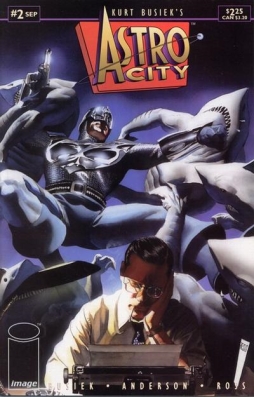 Still, strong as the art is, it’s clearly Busiek’s writing that makes the book stand out. That’s rare in super-hero stories; they’re one of the most visual forms of a visual medium, and much of the great work in the genre has been done by great artists. Busiek’s got a very writerly approach to his work, but also a strong sense of how to tell a story visually: how to structure a narrative around an image or set of images.
Still, strong as the art is, it’s clearly Busiek’s writing that makes the book stand out. That’s rare in super-hero stories; they’re one of the most visual forms of a visual medium, and much of the great work in the genre has been done by great artists. Busiek’s got a very writerly approach to his work, but also a strong sense of how to tell a story visually: how to structure a narrative around an image or set of images.
Which is to say that his work is strong in the super-heroic fundamentals; and you can also see that in his strong sense of structure and of plot. His stories are designed so that, for the most part, the outcome of events doesn’t depend on the outcome of a super-heroic action scene — but may be triggered or inspired by the presence of the scene. That is, the epiphany or final choice a character makes is determined by the genre element, the hero, the villain; but is not directly due to the conflict of hero and villain, to which the main character may be no more than an onlooker. It’s an oddly impressionistic kind of super-hero story.
Busiek’s plot sense has the same formal perfection as his sense of story structure. He’s capable of introducing an amusing-seeming alien as a pseudo-villain, only to have that character’s actions lead to a major story-arc a little further down the line. At which time he’ll also juggle several other plot elements within that same arc. One of the hallmarks of super-hero comics, and something that rarely makes it through to super-hero stories in other media, is the balancing of different genres alongside each other: fantasy and science fiction and horror. Aliens, wizards, and ghosts. Busiek manages to fit it all in, and makes it feel unforced. His ability to move easily between plots, to glance quickly on a story or set of stories in a caption before moving on with his main tale, again creates an impressionistic sense. The kinds of stories being told within a story shape the feeling of the overall story. “The Dark Age,” set in the 1970s, shows its darkness in the kinds of stories that emerge in the city at that time, stories of revenge and brutality and demonic spirits bringing mayhem. Ten or twenty years before, a new age was being born, a new generation of heroes appearing, bringing new and optimistic stories with them.
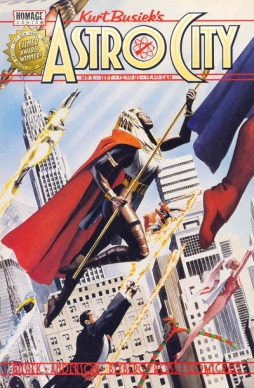 Longtime super-hero fans will note that these examples suggest two of the great ‘ages’ of super-hero comics: the optimistic Silver Age of the sixties, here complete with a hero named the Silver Agent, and the bleaker Bronze Age of the seventies. Busiek’s playing with the history of the genre — with the kinds of stories you’d expect to find in a given era, and hence with the way that comics, a pop art, reflected the popular sensibility of that time. Or the way comics reflected the way the time wanted to think of itself. It’s fairly basic, in one sense — many recently-made super-hero universes give themselves a history based around the familiar pattern of gold, silver, and bronze ages — but Busiek handles the idea with insight, mining the history of comics for parallels with broader social history, using the generational backdrop as a way of creating a large depth-of-field for his characters’ lives.
Longtime super-hero fans will note that these examples suggest two of the great ‘ages’ of super-hero comics: the optimistic Silver Age of the sixties, here complete with a hero named the Silver Agent, and the bleaker Bronze Age of the seventies. Busiek’s playing with the history of the genre — with the kinds of stories you’d expect to find in a given era, and hence with the way that comics, a pop art, reflected the popular sensibility of that time. Or the way comics reflected the way the time wanted to think of itself. It’s fairly basic, in one sense — many recently-made super-hero universes give themselves a history based around the familiar pattern of gold, silver, and bronze ages — but Busiek handles the idea with insight, mining the history of comics for parallels with broader social history, using the generational backdrop as a way of creating a large depth-of-field for his characters’ lives.
That dextrous handling of heroic history is what makes new Astro City such an intriguing proposition. American super-hero comics have changed considerably in the years since the first issue came out. Influenced by manga, they’ve adopted a different storytelling style, with fewer panels per page. The approach to story’s changed, too, with different techniques used to create a sense of verismilitude: a different take on dialogue, a different take on violence, a different take on sexuality. Cross-title events have become ubiquitous. How will the title change to reflect current comics and a new pop sensibility?
Busiek starts out with a change in narrator, a different kind of framing technique. He introduces new characters, new mysteries, hinting at a grand plot to be unveiled in stories to come. It’s clearly only the beginning. But it’s also highly promising.
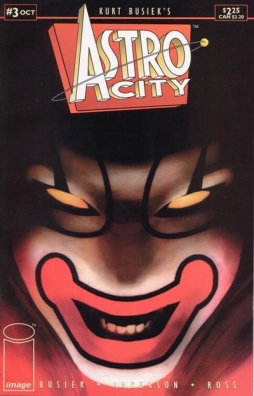 Promising, because Busiek’s extremely conscious of the conventions of super-hero comics, how and when those conventions emerged, and how one can play with them. He’s not afraid to use common ideas, but uses them often stunningly well. Look over past issues and you can see it for yourself. Villains seeking redemption; heroes tempted; kid sidekicks looking to prove themselves — they’re all there in Astro City somewhere, but there’s something different about them. Partly it may be that they’re freed of the demands of a company continuity, demanding that they never change or, conversely, forcing them through unlikely character contortions. But mostly it’s just the fact that Busiek’s able to use those conventions, those elements of plot, entirely and unexpectedly in the service of character.
Promising, because Busiek’s extremely conscious of the conventions of super-hero comics, how and when those conventions emerged, and how one can play with them. He’s not afraid to use common ideas, but uses them often stunningly well. Look over past issues and you can see it for yourself. Villains seeking redemption; heroes tempted; kid sidekicks looking to prove themselves — they’re all there in Astro City somewhere, but there’s something different about them. Partly it may be that they’re freed of the demands of a company continuity, demanding that they never change or, conversely, forcing them through unlikely character contortions. But mostly it’s just the fact that Busiek’s able to use those conventions, those elements of plot, entirely and unexpectedly in the service of character.
In the long run, that’s what makes the book: the focus on character. Virtually every story’s given a different first-person narrator (or, occasionally, narrators), re-telling events from some future point. It allows for heavy foreshadowing, but also allows Busiek to structure the story in a way that’s significant for the character — they’re naturally going to focus on the moment that’s most important for them, building to the key moment as they see it. It also allows Busiek to easily bring in reminiscences and flashbacks, establishing character history and building his setting.
And it means that character becomes indissoluble from the story of the character: again, story is central. I don’t know how deliberate it is, but it’s something that returns through the series in a number of ways. The first character of the first story is a kind of Superman figure, a vastly powerful moral paragon called Samaritan; he works as a fact-checker at a newsmagazine in his civilian identity, meaning that the series’ greatest hero has a job helping to keep stories together. The second issue gives a flip side to that, telling the story of a young reporter witnessing a tremendous battle, and the story he ends up writing for his paper as a result. The third issue features a low-level thug who happened to come across a hero’s secret identitiy, and his struggle to work out what to do with his knowledge — to whom he should tell his story. And so on it goes, with increasing sophistication: the woman who writes super-hero comics (true stories, mostly); the soap-opera actor playing the part of a super-hero added to a show to provide a touch of realism (he ends up having to stage a fight, telling a specific story in super-heroic idiom); the little girl super-hero who runs away from the wonders of her family’s headquarters to join the story of the regular kids at a neighbourhood school; the archenemy of Samaritan, who recognises he and his opponent are figures out of a myth, but cannot tell who is which character.
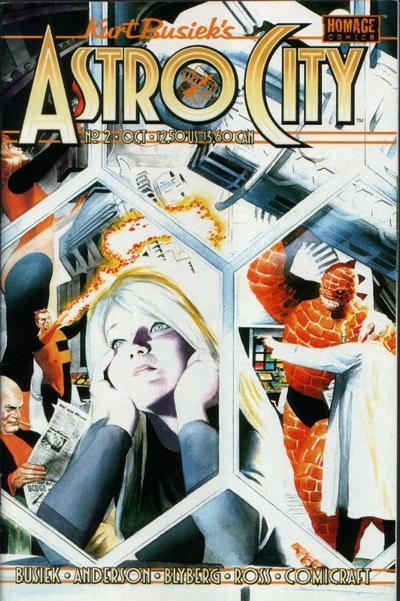 It’s as though Astro City’s a kind of summation of the whole super-hero tradition. That’s literalised in the place-names of the city: Binderbeck Square, Fox–Broome University, Fort Kanigher, all of it in the shadow of Mount Kirby (home to the Furst Family). Mind, the names actually have a broader base than that — you can find references to all kinds of comics on a map of Astro City, from the Outcault Bridge to a French restaurant called Goscinny’s to Gainesville and the Gaines Riverport. Still, it seems as though Astro City as a setting is a kind of incarnation of the super-hero: it’s the perfect venue.
It’s as though Astro City’s a kind of summation of the whole super-hero tradition. That’s literalised in the place-names of the city: Binderbeck Square, Fox–Broome University, Fort Kanigher, all of it in the shadow of Mount Kirby (home to the Furst Family). Mind, the names actually have a broader base than that — you can find references to all kinds of comics on a map of Astro City, from the Outcault Bridge to a French restaurant called Goscinny’s to Gainesville and the Gaines Riverport. Still, it seems as though Astro City as a setting is a kind of incarnation of the super-hero: it’s the perfect venue.
With that, I think some problems arise. Most notably, there’s a sameness of voice from character to character. Vocabulary and syntax don’t change as much as you might expect. It’s possible to argue that this heightens the importance of story — it’s a character’s story that makes them stand out, not tricks of diction. But over the course of several stories, it can lend an oddly generic sense to the title; and if that’s something that’s a common pitfall of super-hero stories, it’s still a pitfall.
Conversely, some characters are perhaps not individuated enough from their models. Busiek’s characters clearly resemble certain established characters. He’s claimed he’s tried to make the inhabitants of Astro City ‘archetypes,’ representing elements common to both Marvel and DC (and other) universes. I don’t think he’s succeeded, in that I tend to find his characters are often really very close to their originals. But I’m not sure it matters: they’re far enough away from their inspirations that they’re new and distinct creations. To the extent you notice the original, it’s only somehow in a broader context: Astro City feels bigger because it’s got both Marvel and DC characters, fighting alongside each other.
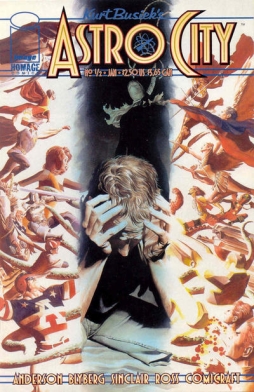 Still, I suspect what makes the series work, in the end, is the fact that Busiek uses the super-hero genre to tell stories you wouldn’t see elsewhere. He gets at emotional tones not normally associated with super-hero books. When I gave my copies to my girlfriend to read, she observed that they were some of the saddest comics she’d ever seen. This surprised me, in part because it’s really very true. Astro City gets at the bombast and energy of the genre, but there’s a melancholy to it as well, an undertone of sadness that emerges in almost every story to a greater or lesser extent. The retrospective narration enforces that sadness, but it’s also a sign of how carefully Busiek’s working with his genre: stories dealing with characters who can accomplish virtually anything become about their limitations and their awareness of their limitations. You can see elements like that in previous hero comics — Superman obsessing over dead Krypton, Spider-Man’s eternally rotten luck — but Busiek moves the melancholy of his stories closer to their heart. These characters accept their limitations in a way corporate heroes can’t; that can be heartbreaking, or rewarding, or both those things at once and many other things as well.
Still, I suspect what makes the series work, in the end, is the fact that Busiek uses the super-hero genre to tell stories you wouldn’t see elsewhere. He gets at emotional tones not normally associated with super-hero books. When I gave my copies to my girlfriend to read, she observed that they were some of the saddest comics she’d ever seen. This surprised me, in part because it’s really very true. Astro City gets at the bombast and energy of the genre, but there’s a melancholy to it as well, an undertone of sadness that emerges in almost every story to a greater or lesser extent. The retrospective narration enforces that sadness, but it’s also a sign of how carefully Busiek’s working with his genre: stories dealing with characters who can accomplish virtually anything become about their limitations and their awareness of their limitations. You can see elements like that in previous hero comics — Superman obsessing over dead Krypton, Spider-Man’s eternally rotten luck — but Busiek moves the melancholy of his stories closer to their heart. These characters accept their limitations in a way corporate heroes can’t; that can be heartbreaking, or rewarding, or both those things at once and many other things as well.
At the same time, Busiek’s ready to pull his stories in yet further directions. Notably, he’s aware of the closeness of the super-hero story to the horror story and to the gothic (something I’ve mentioned before). One of the regions of Astro City is Shadow Hill, a neighbourhood dominated by immigrants originally from Eastern Europe — complete with Eastern European superstitions. Its guardian is a spectre (as it were) named the Hanged Man. So the fourth issue of the book followed a woman from Shadow Hill, Marta, trying to decide between living a life among her family’s neighbourhood or among the super-heroes of the rest of the city. Marta’s conclusion revolves around the realisation that there’s not much difference between the two: both operate according to rules. Both have heroes, and monsters, and charms, and talismans — symbols.
And there’s another story much later, a two-part tale set in the dark age of the 1970s, following a defence lawyer, Vince Oleck, who finds an effective way to raise a reasonable doubt in a jury’s mind about the seeming sure guilt of a psychopathic mobster. At the same time, there’s a murderous spirit of vengeance killing criminals. It all works itself out in ways you don’t expect, but the points I want to bring up here are these: firstly, the story identifies itself explicitly, in Oleck’s recollection, as a horror story. Secondly, and as a result of that, it’s an examination of what happens when charms and talismans fail.
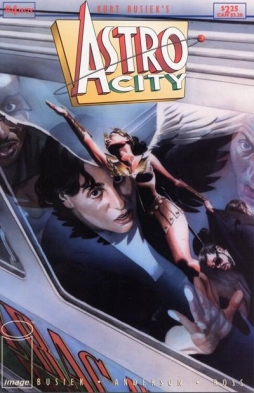 At one point, when some mobsters threaten Oleck’s family, there’s a sequence of captions, which reads (paragraphing approximated):
At one point, when some mobsters threaten Oleck’s family, there’s a sequence of captions, which reads (paragraphing approximated):
Have you ever had one of those moments where reality just kind of — breaks? Where the world made sense one second, and the next, it doesn’t? Gravity, physics, history, everything — They’re just — gone —
— and there’s nothing around you but emptiness. Chaos. Those moments never last. But for a split second, everything’s different — it’s like a veil has been pulled away, and you can almost —
— you can almost see something. Feel something. Something you can’t quite grasp. And then it’s gone. Everything’s normal, and you write it off to cold medicine, or lack of sleep. I’d been doing my job. Thinking that if I served the system, the system would serve me — keep me safe. Like it was a game, a dance. But it wasn’t a game. And the rules … the rules wouldn’t save me.
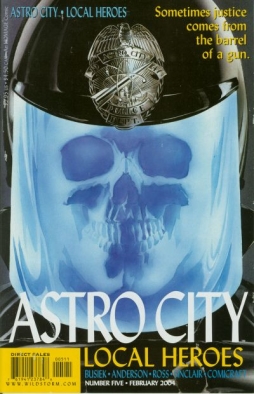 That’s absolutely an encounter with horror. Not just a bad thing, but a vision of darkness underlying the world. What’s it doing in a super-hero book? Well, by the end, there’s a semblance of normality back in place, as Oleck ponders his job in the present, “teaching the dance” of criminal law:
That’s absolutely an encounter with horror. Not just a bad thing, but a vision of darkness underlying the world. What’s it doing in a super-hero book? Well, by the end, there’s a semblance of normality back in place, as Oleck ponders his job in the present, “teaching the dance” of criminal law:
We have rituals. Quirks. Habits. Some are small. Some not so small. We dance against the dark. We dance every day. And if we dance well …
… the shadows stay where they belong.
This relates I think to Marta’s story, and to the nature of Astro City and superheroes as a whole. Super-heroes are creatures of these rituals; of the charms, the talismans, the dance of law and crime, of hero and villain. It’s like a game, but is no game, and perhaps it is when you think it’s only a game that you’re at risk of losing. What Astro City tells us is that super-heroes are creatures of highly formalised genre conventions; of carefully-staged action; of masks and costumes — and therefore of theatre; and all of this is to say that they are ritual. A ritual, Busiek’s suggesting, one of many kinds of ritual, that holds back horror. Perhaps storytelling of any kind is that ritual, storytelling in print or upon a stage or through the use of words and pictures, together or apart. In an afterword to the first issue of Astro City, Busiek described the act of telling a story in comics by himself telling a story about a storyteller in a shadowy wood telling a tale around a fire. The story, like the fire, holds back the night, and the horrors beyond the fire.
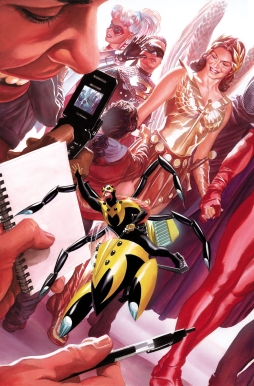 The conventions of the super-hero story are a beat, a measure to be trodden out. The heroes and the villains are talismans; as, Marta observes, so many heroes are identified by some simple visual symbol (think of the familiar heroes we know: a spider, a bat, a stylised ‘s’). They are a way of keeping the darkness at bay. That’s what heroes do: stand against horror.
The conventions of the super-hero story are a beat, a measure to be trodden out. The heroes and the villains are talismans; as, Marta observes, so many heroes are identified by some simple visual symbol (think of the familiar heroes we know: a spider, a bat, a stylised ‘s’). They are a way of keeping the darkness at bay. That’s what heroes do: stand against horror.
And so, in this sense, heroes are not only within the story. Storytelling, we learn, is a heroic act. Who can tell the dancer from the dance?
The next issue of Astro City hits stores on July 10.
Matthew David Surridge is the author of “The Word of Azrael,” from Black Gate 14. His ongoing web serial is The Fell Gard Codices. You can find him on facebook, or follow his Twitter account, Fell_Gard.
I’ve been a longtime fan and admirer of Astro City; glad to see it return. With Vertigo, it has a fitting home.
Very interesting article Matthew, thanks for drawing my attention to Astro City. I enjoyed your closing argument about stories–heroic stories–being part of the ritual, even rituals themselves, at keeping the darkness/horror/evil away. And ‘Storytelling, we learn, is a heroic act.’ is simply an astounding statement – such a simple concept that imparts so much.
I must confess a bias to judging comics by their art and not being a fan of parody very much, so while the art on most of the covers above does impress, the cover depicting the faux-Fantastic Four really repels me. I will rely on your description of the contents and writing though, and at least begin reading these.
Thanks!
With the new re-launch, I had this recommended to me. I just stumbled on the first collected trade volume of the original. I was surprised to see that it was reissued in 2011, yet most of the volumes are basically out-of-print status on Amazon. So, I think maybe only the first volume got the reprint.
Anyway, it is a title I want to delve into. The comic store owner also gave it great praise when I bought it.
I read these a few years back and loved his playing with the archetypes. Far from parody, they display a deep reading and love of superheroes. I itching to read the new stuff.
I’m itching. Sheesh.
Thanks for the kind words, everyone!
Jason: Glad you liked that bit about storytelling as heroism; it was one of those things that really hit me as I was typing it. I have an idea I might be on to something there.
Anyway, I’d say there’s no worries about parody. Busiek’s inspirations are clear, but his characters aren’t meant to be poking fun at Marvel or DC. They’re reminiscent without being derivative, is what I’d say.
Though it’s also important to point out that the guy who does the covers, Alex Ross, is not the same guy who does the interiors. That’s much more standard pen-and-ink super-hero comics art. I think it’s very well done, with strong storytelling, but it’s very different from the covers.
(If you do want to see Alex Ross on interior artwork, I strongly recommend Marvels, also written by Kurt Busiek. It’s a kind of street-level look at the early Marvel universe. Very moving stuff!)
I remember buying the first issue when it came out, following a review or mention somewhere and being blown away. Concept, character, sense of place and artwork all strikingly well done. I’ve bought each trade collection as it was published and it’s time to pull them out for a rereading. Excellent article!